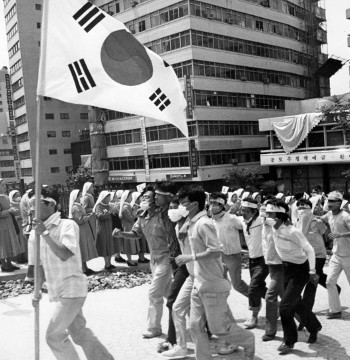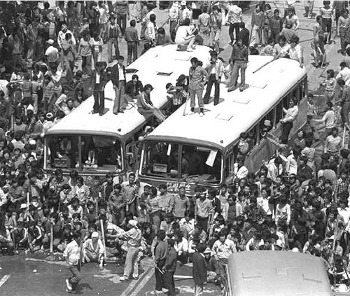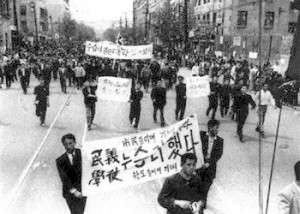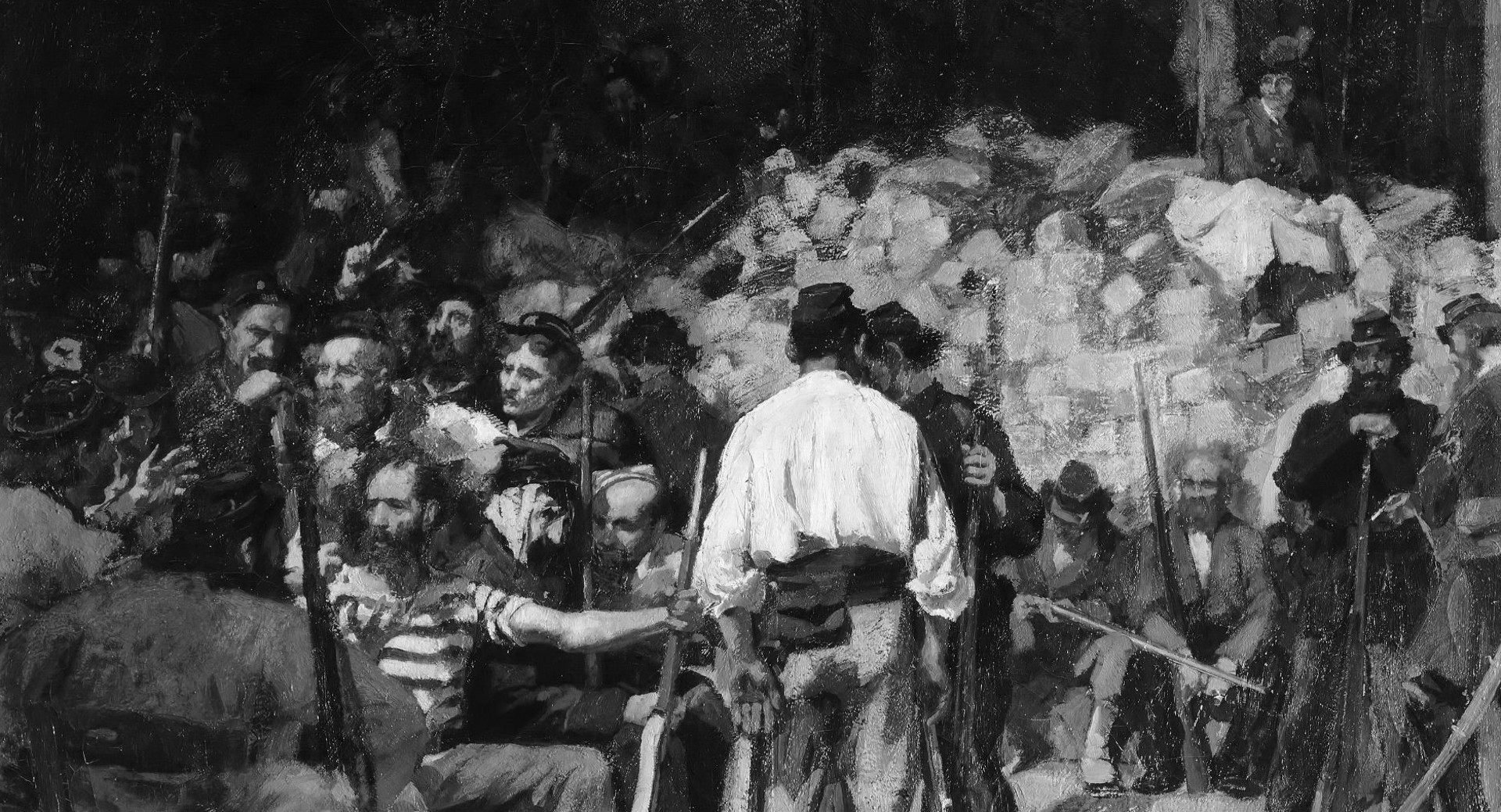Gwangju Uprising
Like the Paris Commune of 1871, the lesser-known Gwangju Commune of 1980 stands as a concrete embodiment of freedom’s phenomenological form.
The Commune: Evolving Form of Freedom
- Issue #1
- Author
From revolutionary armies and parliaments at the end of the 18th century, to workers’ and soldiers’ councils at the beginning of the 20th, grassroots insurgencies create new forms of power. In contrast to occupational or sectoral forms of self-government, communes—liberated spaces within which universal popular will is formulated through direct democracy and implemented by direct action—have been continually generated from below, the most famous example being the 1871 Paris Commune.
Among today’s European and American activists, there is widespread knowledge of Paris while only sparse and superficial recognition of the 1980 Gwangju Commune. One might have thought that a more contemporaneous event would be better known than its 19th century antecedent, yet, for a variety of reasons, including deeply rooted Eurocentric bias, the opposite is the case.
Our scant knowledge of contemporary communes can also be found in Soviet Communism’s defamation of “spontaneity”, an ideological imperative that reached such extremes that popular movements outside the control of the Communist Party were opposed from the time of Makhno.
More recently, in 1968 France and 1977 Italy, Communist Parties opposed insurgencies and sided with governments. Insurrections in the early 20th century—in St. Petersburg and Moscow in 1917, Budapest and Bavaria in 1919, and Hamburg, Canton, and Shanghai in 1923—were led by Leninist organizations intent on seizing power. In China, Korea, and Vietnam, protracted wars led by centralized parties were vital to national liberation.
Looking at the history of uprisings in the 18th and 19th centuries, one discerns a far different orientation of revolutionaries. Both Marx and Lenin enthusiastically embraced the Paris Commune as the embodiment of their aspirations. For Peter Kropotkin, the free commune became the ends and means of genuine revolution. He detested representative government and bureaucrats who sought to take upon themselves the responsibilities and rights of the people. Developing his thoughts in relation to the Paris Commune of 1871 as well as the Cartagena and Barcelona Communes that followed a few years later, Kropotkin noted that uprisings themselves inspired others to rise up—a phenomenon I understand as the eros effect. Kropotkin believed that, “Not one, or two, or tens, but hundreds of similar revolts have preceded and must precede every revolution. Without these no revolution was ever wrought.”
 Like the Paris Commune, Gwangju’s historical significance is international. Its lessons apply equally well to East and West, North and South. The 1980 people’s uprising, like earlier revolutionary moments, continues to have worldwide repercussions. An example of ordinary people taking power into their own hands, it was a precursor of the Asian Wave that overthrew eight dictatorships in the six years from 1986 to 1992.
Like the Paris Commune, Gwangju’s historical significance is international. Its lessons apply equally well to East and West, North and South. The 1980 people’s uprising, like earlier revolutionary moments, continues to have worldwide repercussions. An example of ordinary people taking power into their own hands, it was a precursor of the Asian Wave that overthrew eight dictatorships in the six years from 1986 to 1992.
As the world-historical global movement of 1968 etched the contours of subsequent insurgencies—the disarmament movement in the early 1980s, vast mobilizations in Russia and Eastern Europe after 1989, the alterglobalization wave most visible in 1999 Seattle, and the 2011 global uprising (the Arab Spring, Greek anarchists, Spanish indignados, Wisconsin workers and Occupy Wall Street)—so the Paris Commune paved the way to the Gwangju Uprising, and Gwangju for subsequent waves—and not only in Asia.
Even when an uprising is brutally suppressed—as in both cases here—its being experienced publicly creates new desires and new needs, new fears and new hopes in people’s hearts and minds. In 1987, when South Koreans rose up in their historic 19-day June Uprising that finally overthrew the dictatorship, “Remember Gwangju!” was the key rallying cry. Two years later, on May 20, 1989, Chinese workers and students occupying Tiananmen Square invoked the memory of the Paris Commune in a joint statement in which they proclaimed that, “We will build another Wall of the Communards with our life’s blood.”
Comparing the Paris Commune and the Gwangju Uprising
In both Paris and Gwangju, citizens opposed their governments and effectively gained control of major cities in which hundreds of thousands of people created popular organs of political power that efficiently replaced traditional forms of government; grassroots armed resistance was widespread; criminal behavior all but disappeared and was replaced by genuine solidarity and cooperation among the citizenry; hierarchies of class, power, and status were suspended.
Both uprisings were produced by the accumulation of grievances against injustice and precipitated by extreme events. The Paris Commune arose in 1871 at the end of the Franco-Prussian War when the victorious Prussians advanced on the capital. When the National Assembly voted to surrender to Prussia, Parisians were disgusted.
With the support of 215 of the existing 260 National Guard battalions, the National Guard of Paris seized control of the city in a coup d’état on March 18. Resisting their own government’s attacks, the Communards held out for 70 days against French troops armed and aided by their Prussian conquerors. The Communards established a functioning government that coordinated defense and met Parisians’ daily needs. Twice, elections were held. Finally, on May 28, overwhelming military force crushed the uprising, and thousands were killed in a “Bloody Week” of urban warfare.
Over a century later, the Gwangju People’s Uprising occurred at a time when the firepower of militaries was multiplied by several orders of magnitude. There was no conquering foreign army advancing on the city, but horrendous barbarity was inflicted on the people of Gwangju by elite South Korean paratrooper units pulled off the front lines with North Korea with the approval of the United States. Against flamethrowers and machine guns, thousands of people bravely fought back and drove the military out of the city.
Inside liberated Gwangju, daily citizens’ assemblies of tens of thousands of people gave voice to years-old frustrations and pent-up aspirations of ordinary people. Local citizens’ groups maintained order and created a new type of government—one of, by, and for the people. They held their liberated space for six days, a far shorter period than the Paris Commune. During such revolutionary moments, however, time is not a key variable—at least not as we ordinarily measure it. On May 27, 1980—almost the same day that the Paris Commune was crushed 109 years earlier—the Gwangju Commune was overwhelmed by tanks, helicopters, jets and thousands of paratroopers.
In order to contain both uprisings, to prevent them from spreading, the established governments isolated them. Cut off from the provinces, the Paris Commune nevertheless found many supporters, and similar communal experiments erupted in many cites, from Marseille to Tours. In Gwangju, the revolt spread to at least sixteen neighboring sections of South Cholla province.
As in Paris, where Courbet participated in an artists’ group that supported the Commune in many ways—most notably by tearing down the Vendôme column—artists in Gwangju also played vital roles. Clown theater groups took a central role in MC’ing the daily rallies; Hong Sung-dam and visual artists made posters for the movement and the uprising’s daily newspaper.
During both uprisings, women played significant roles, although they organized themselves in domains considered traditionally female within today’s patriarchal division of labor. Strong feminist sentiment emerged among women in the International Workingmen’s Association (IWA—also known as the First International) who took on care of the injured. IWA women demanded gender equality and the abolition of prostitution. They organized worker cooperatives, like the restaurant La Marmite, which served free food for indigents.
Although barred from voting in initial elections, women were enfranchised by the Commune. In Gwangju, high school girls gathered and washed the corpses and helped care for the wounded. Although a few men were involved in cooking communal meals in Province Hall and around the city, women mainly staffed the public kitchens. While some women carried arms during the Gwangju Uprising, a separate female battalion of the National Guard fought to defend Place Blanche when the Prussians and their French allies attacked.
 In both cities, traitors to the uprisings and government supporters (including spies and saboteurs sent inside the Communes to disrupt and destroy them) were quite numerous. In Gwangju, government agents took the detonators from the basement of Province Hall, thereby rendering useless the dynamite brought there by Hwasun coal miners. Paris was “full” of internal enemies, and there were riots at Vendôme Place and the Bourse, instigated by “loyal” citizens in constant contact with Versailles.
In both cities, traitors to the uprisings and government supporters (including spies and saboteurs sent inside the Communes to disrupt and destroy them) were quite numerous. In Gwangju, government agents took the detonators from the basement of Province Hall, thereby rendering useless the dynamite brought there by Hwasun coal miners. Paris was “full” of internal enemies, and there were riots at Vendôme Place and the Bourse, instigated by “loyal” citizens in constant contact with Versailles.
Nevertheless, the liberated realities of the Communes in Paris and Gwangju contradict the widely propagated myth that human beings are essentially evil and require strong governments to maintain order and justice. The behavior of citizens during these moments of liberation revealed an innate capacity for self-government, an instinct for peaceful cooperation.
The defeated governments, not the autonomously governed people, acted with cruelty. In both 1871 and 1980, after the halcyon days of liberation were bloodily brought to an end, brutal repression was the meaning of “law and order.” Estimates of the number of people executed in the aftermath of the Paris Commune reach to 30,000, a number that does not include the thousands more who were summarily deported to distant Pacific holdings of the French Empire.
In Gwangju, far fewer people were killed. Although today’s official count of the dead hovers around 200, most people then believed that at least 2,000 had been killed in the uprising. Hundreds disappeared. Even after the Gwangju Commune, the news of the uprising was so subversive that the military burned an unknown number of corpses, dumped others into unmarked graves or the sea, and destroyed its own records.
To prevent word of the uprising from being spoken publicly, thousands of people were arrested, and hundreds tortured as the military tried to suppress even a whisper of its murders. At least a dozen people committed suicide as they proclaimed the truth of the massacre.
Both uprisings took place after many years of economic growth. The 1872 census put the number of industrial workers in France at 44 percent of the workforce, but there were probably no more than 15 factories that employed more than 100 workers each, and an additional hundred factories employed between 20 and 50 workers. Similarly, Gwangju in 1980 was the site of many small factories, a feature typical of the transition to higher forms of industrialization.
Differences Between the Two Uprisings
In Gwangju, no preexisting armed force like the Parisian National Guard led the assault on power. Rather grassroots resistance to the brutality of the paratroopers threw forward men and women who rose to the occasion and ultimately organized themselves as the Citizens’ Army. Liberated Gwangju came into being without the contrivance of political parties or preexistent governmental bodies. In the latter part of the 20th century, the Gwangju Commune reveals people’s capacity to govern themselves far more wisely than military dictatorships or tiny elites—elected or not.
Like the insurgents of 1789, Parisian Communards considered the churches as enemy territory. In the first week of April, more than 200 priests were arrested, mainly through neighborhood initiatives. Without anyone telling them to do so, people turned parishes into community centers, orphanages and refuges where the city’s poor could rest.
In Gwangju, by contrast, churches significantly supported the uprising. Many churches became meeting places for their parishioners to discuss the Commune and to participate in it, and the YMCA and YWCA were convergence centers for some of the most radical insurgents. No one was executed in liberated Gwangju. In Paris, as the city was about to fall, the Archbishop of Paris and a handful of priests were executed.
The Paris Commune included people of many European nationalities. Italian, Polish, German, Swiss and even Russian expatriates participated as equals. One of the commanding generals in charge of the city’s defense was a Pole, and a Hungarian was elected to the government. While in Gwangju few foreigners were positioned—geographically or linguistically—to partake in the movement, Korean xenophilia welcomed journalists and even missionaries, who were applauded and welcomed
 Daily rallies of tens of thousands of people in Gwangju provided a forum for direct democracy where differences of opinion were passionately debated. People from all walks of life addressed the entire city—including leaders of criminal gangs who promised solidarity. Shoeshine boys, prostitutes, and people normally considered to be at the “bottom” of society participated as equals.
Daily rallies of tens of thousands of people in Gwangju provided a forum for direct democracy where differences of opinion were passionately debated. People from all walks of life addressed the entire city—including leaders of criminal gangs who promised solidarity. Shoeshine boys, prostitutes, and people normally considered to be at the “bottom” of society participated as equals.
Whereas in Paris, elected leaders issued proclamations, in Gwangju people made decisions directly. Two significant such determinations were not to surrender to the military (as some advocated) and to trade the military hundreds of weapons (a tiny fraction of the thousands in the hands of the insurgents) in exchange for the release of dozens of prisoners. When the General Assembly vocalized needs that required action, groups immediately took appropriate measures. So powerfully influential and intelligent were the deliberations of these assemblies that Gwangju citizens struggled for 17 years after the uprising to realize the three demands endorsed by tens of thousands of people in 1980: punishment of those responsible for the massacre; an apology to citizens; and compensation to victims and their families.
Unlike Gwangju’s general assemblies and direct democracy, a variety of representative structures existed in Paris. After the coup of March 18, the Central Committee of the National Guard immediately became the new government. Paris was full of already constituted organizations and parties, such as the First International to which Marx and Bakunin belonged, although at the beginning of the uprising its Parisian branch had no political program.
To legitimate the Commune, elections were held on March 26, and 287,000 men voted. Ninety members of the Commune were elected—but they included fifteen government supporters and nine citizens against the government but also against the March 18 insurrection. The next day, 200,000 people attended the installation of the new government at the Hôtel de Ville (City Hall).
Unlike the free-flowing gatherings in Gwangju where everyone had a voice, the crowd in Paris watched as their representatives were sworn in, after which they simply left. The newly elected government proclaimed the enfranchisement of women, separation of church and state, no more night work in bakeries, no back rent for the poor, the arrest of reactionary priests, the re-opening of abandoned factories, and abolition of fines against workers—the last measure permitting workers to reclaim their tools from the city’s pawnshops.
Elected representatives, however, were not the only power. Neighborhood associations acted as a “shadow government.” Three separate groups convened to make decisions at the Place de la Corderie, sometimes issuing manifestos together and at other times in opposition to each other. In many arrondissements, separate subcommittees formed and issued their own instructions.
 In addition, National Guard commanders also gave independent orders to their units. Within the cacophony of directives, officers in the field sometimes received three sets of conflicting orders. As a result, the elected government was practically powerless, rivaled in military affairs by the Central Committee and diminished in political power by autonomous arrondissement associations.
In addition, National Guard commanders also gave independent orders to their units. Within the cacophony of directives, officers in the field sometimes received three sets of conflicting orders. As a result, the elected government was practically powerless, rivaled in military affairs by the Central Committee and diminished in political power by autonomous arrondissement associations.
Tragically, the elected government was also mired in personal antagonisms among its members and depleted by elected representatives who refused to serve or resigned. Most significantly, it was weakened internally by those loyal to the old government, the bitter enemy of the Commune. Bad decisions—or a lack of any decision at all—soon became commonplace. Finally, as the representative system collapsed, on May 1, by a vote of 34 to 28, the government created a Committee of Public Safety “having authority over all…”
It appears that ordinary Parisians were not in favor of representative government, preferring instead direct democracy. As Prosper-Olivier Lissagaray tells us: “the popular masses, insensible to the bourgeois ideal of a municipal council, were bent on the Commune . . . What did they care for a council, even elective, but without real liberties and fettered to the state—without authority over the administration of schools and hospitals, justice and police, and altogether unfit for grappling with the social slavery of its fellow citizens?”
Here we see the most significant dimension of Paris and Gwangju: through substantive democracy—a far more empowering system than elections to choose rulers—the people of Paris and Gwangju reveal the trajectory of future forms of freedom. While elections in Paris led to increasing centralization of power in the hands of the Committee of Public Safety, in Gwangju—despite the continual combat against the military—people resolutely maintained the communal form of deliberative democracy.
The Legacy of Communes
The memory of the 19th century Paris Commune affected activists in Gwangju in 1980. In the course of dozens of interviews with former fighters in Gwangju, I found many people for whom the historical memory of the Paris Commune provided inspiration. Such direct connections illustrate how the legacy of uprisings, whether in Paris or Gwangju, is to empower others to struggle in the future. In the wake of both Paris and Gwangju, people were motivated, consciously or not, to participate in future struggles.
In the latter half of the 20th century, the revolutionary commune reappeared—initially in opposition to real-existing Communism. As early as 1957, Cornelius Castoriadis posited the deliberative decision-making of 1956 Hungarian workers’ councils as a model. Late 20th century grassroots Asian communes also have a robust history.
Besides liberated Gwangju, massive takeovers involving direct democracy occurred at Bangkok’s Thammasat University in 1973, in Beijing’s Tiananmen Square in 1989, in Patan (Nepal) in 1990, and in Taipei’s Chiang Kai-shek Square in 1990. Similar 21st century communes, however paltry and malformed, emerged in Istanbul’s Taksim Square, in Cairo’s Tahrir Square and in Oaxaca’s central plaza. Like the rapid proliferation of Occupy Wall Street’s direct democracy, these insurgencies reveal people’s collective wisdom and capacity for self-government.
Looking ahead, we can expect waves of uprisings and newly generated communes to emerge on every continent. Whether or not they are synchronized and act in concert with each other may be a deciding factor in their long-term success. Today, the Paris and Gwangju Communes stand as concrete embodiments of the evolving form of freedom. They continue to provide all of us with a palpable feeling for the dignity of human beings and the possibility of freedom.
Source URL — https://roarmag.org/magazine/katsiaficas-paris-commune-gwangju-uprising/
Next Magazine article
The Survival of the Paris Commune
- Kristin Ross
- March 18, 2016
The Commune Lives
- ROAR Collective
- March 18, 2016


